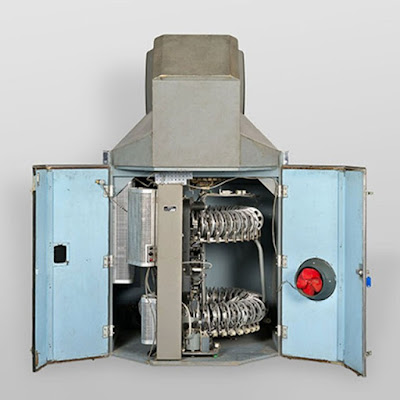 |
| An American Scopitone 450 jukebox. Image: Scopitone Archive |
Although not the first of it's kind (there are mechanical and human assisted, silent and black and white examples of coin operated on-demand movie systems going back to the early 1900s, including the 1940s Panoram and the notorious "peep-show" private viewers), the Scopitone and Cinebox were different in that they were all electric, had sound and they were in colour.
Actress Joi Lansing made Scopitone's most famous (and cheesiest) film "The Web Of Love" in 1965.
One distinctive thing about Scopitone films were most of the musical numbers all had girls (and some guys) doing go-go dancing of some sort.
They were invented in Europe. First the Scopitone in France and it's similar rival, the Cinebox in Italy where they became wildly successful. The Cinebox came to America first in 1963 and was quickly followed by the Scopitone. However, the Scopitone instantly created a media buzz and a fad in countless cocktail lounges and public waiting areas in the mid 1960s.
One early investor in Scopitone's American division was actress Debbie Reynolds.
Restaurant and lounge owners quickly signed up after reading the salesman's brochure. It really looked like The Next Big Thing.
 |
| Scopitone promotional banner |
(Warning: "Fiesta Hippie", although tame by today's standards may still be NSFW.)
Another is Scopitone was mentioned in a federal investigation into organized crime. Fearing a scandal that involves The Mob, many businesses canceled their Scopitone services and returned the machines.
 |
| A Scopitone can hold up to 36 reels of film |
Procol Harum's 1968 hit "A Whiter Shade Of Pale" was the only known rock song available on Scopitone. There was never a release for the Cinebox.
The Scopitone was largely gone by 1970 in America. However, there were still new Scopitone films made, albeit in France. The last known Scopitone film was made in 1978. The old Scopitone projectors were mostly junked, although some were converted into peep show systems for X rated adult film arcades. Only a handful were preserved and are now mostly in museums and private collections.
It's Italian rival, the Cinebox (later renamed Colorama) was actually introduced to America earlier than the Scopitone (1963). Like the Scopitone, it had a very limited American catalog, but LOTS of Italian musical acts.
It too had a short life in America and in spite of being the first video jukebox in America, arriving months before the Scopitone. It was eclipsed by Scopitone's promotional machine, rendering Cinebox as an also-ran to Scopitone. And when the ax fell at Scopitone over the alleged Mob associations, Cinebox also felt it. The public felt like these machines were just tools of the Mob in spite of Cinebox never being involved with that in any way. Besides, neither Scopitone or Cinebox were very profitable overall.
Cinebox also ended it's American distribution and folded completely in 1978.
More on The Scopitone and Cinebox:
Scopitone Archive (Has information on both the Scopitone and Cinebox as well as the Color-Sonic system.)
Scopitones
Scopitone (Wikipedia entry)
Cinebox (Wikipedia entry)
Kitschy Scopitone jukebox brought the jams before MTV











